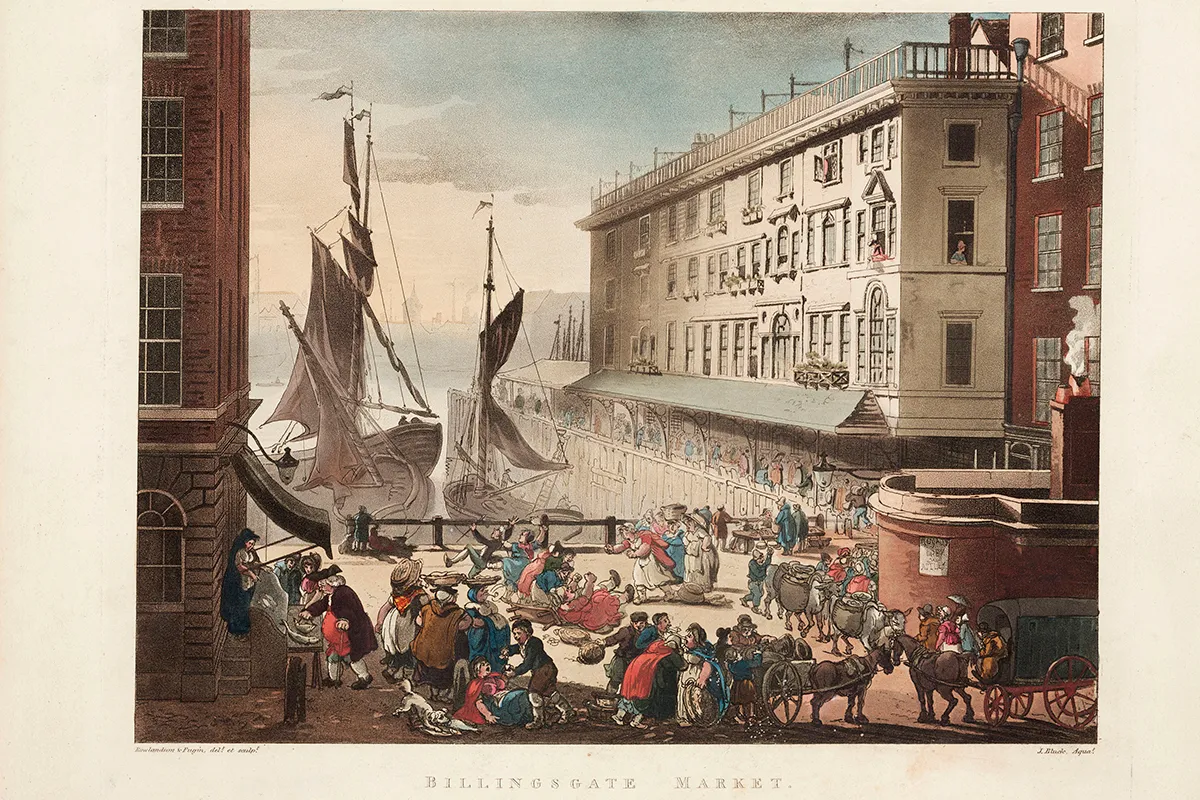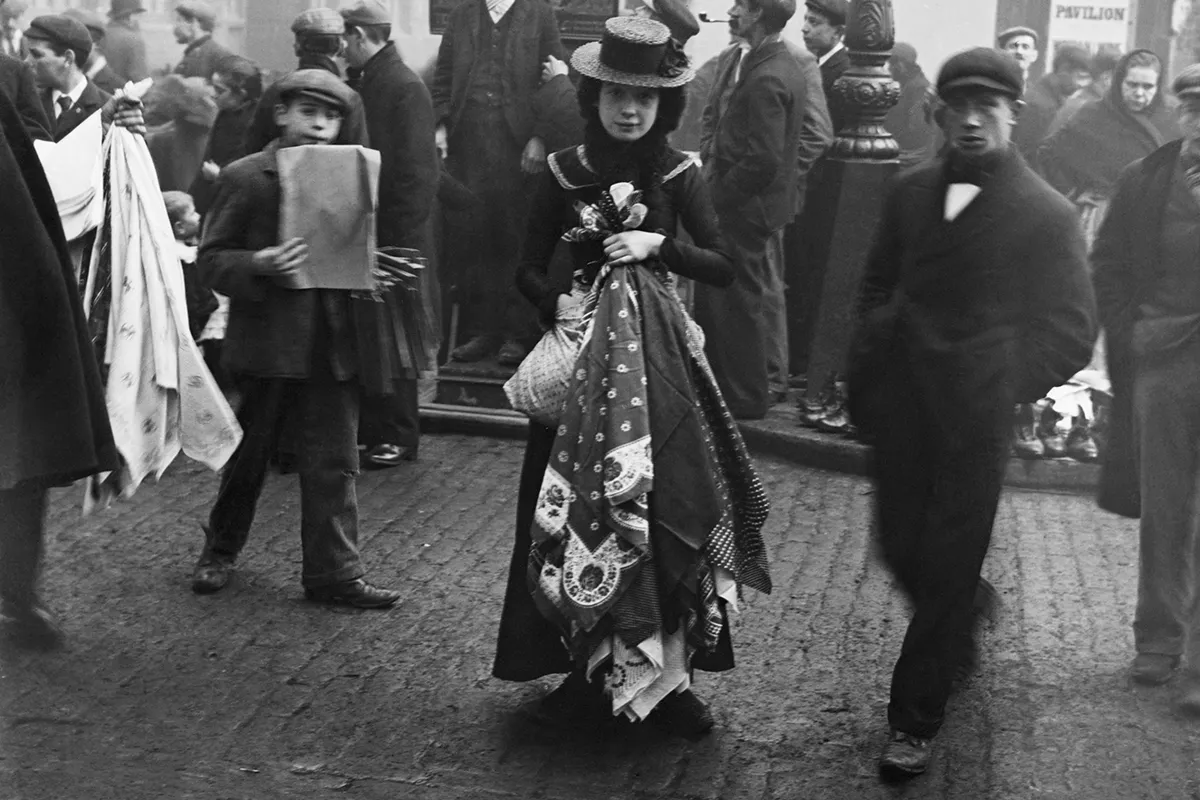“The people crowd the streets, along which no vehicle dreams of passing, chatting with each other, chaffering [haggling] with the sellers, buying what they want or looking on while others buy. The air is bright with flaring lights and resonant with voices.” This is social explorer Charles Booth describing a London street market on a Saturday night in the 1890s, noisy with sellers and shoppers, and dramatically lit by naphtha lamps which produced a naked flame.
At a similar date, the Royal Commission on Markets Rights and Tolls heard evidence from several costermongers: traders who bought fish, fruit and vegetables in the city’s wholesale markets, and sold them from stalls in the streets in markets like that Booth described. One of these was John Denton of Chapel Street Market, Islington. He was questioned by the chair of proceedings Alexander Bruce, 6th Lord Balfour of Burleigh, who asked, “Is there any parish or other authority that gives you leave to take up your particular place?” “No,” replied Denton. Burleigh’s questions probed how Denton and his fellow street sellers plied their trade – did anyone give them permission? Did they pay rent or a fee for their pitch? Did they have a right to its ongoing occupation? Denton kept repeating “No”, adding, “As long as we keep the place clean, and there are no rows, nobody interferes with us.”
What Denton described – and Burleigh struggled to understand – was the informality of London’s street markets. As the city expanded rapidly in the mid-19th century, long-established markets such as Billingsgate (fish), Spitalfields (fruit and vegetables) and Smithfield (meat) turned almost exclusively to wholesale trade. These markets were all formally authorised by ancient charters. As they moved to wholesale, the gap they left in retailing for ordinary people was filled by street sellers.

London had always had many wandering hawkers, walking the streets and selling from barrows, baskets or trays. In the mid-19th century, as the authorised markets ceased to be a place to do everyday shopping, street sellers settled into customary street sites as unregulated small-scale entrepreneurs, part of the informal economy on the edges of legal frameworks or controls.
In many UK cities the ancient chartered markets were housed in new market halls in the mid-19th century, and continued to sell to everyday customers. But in London local government struggled to provide market halls, and the only law that controlled the street markets was the 1867 Metropolitan Streets Act giving the Metropolitan Police limited powers to prevent obstructions and regulate the size of stalls. This situation continued until the 1927 London County Council (General Powers) Act introduced licensing – a process that did very little to change the street markets’ location or character.
How many street markets did London have? In 1851 journalist Henry Mayhew put the total at 37. In 1893 a report by London County Council listed 112, with nearly 5,000 stalls. Forty years later again in 1932 a study by the London School of Economics found that the number of markets was about the same, but the number of stalls had risen by 50 per cent. This growth comfortably outstripped the rapid expansion of the city’s population – clearly the street markets were thriving. The smallest had just a few stalls, the biggest many hundreds. They were scattered right across the city, located in the back streets of the West End and Westminster (for instance Berwick Street and Strutton Ground), in its newer suburbs (places like Lewisham and Peckham) and scattered particularly thickly in the working-class East End, in sites such as Watney Street, Chrisp Street and Petticoat Lane.

The street markets were where Londoners, and certainly most working-class people, shopped for food. The costermongers sold meat, fish, fruit and vegetables, buying cheap whatever was in surplus in the wholesale markets, and selling it at bargain rates. The markets also sold a huge variety of other sorts of goods. In 1893 London County Council itemised the non-food goods sold in the markets, listing all sorts of clothing, and household goods ranging from furniture to carpets to mangles. As time went on, the street markets reflected changes in the economy and their customers’ tastes. The old clothes that were common in the mid-19th century were replaced by new garments, and by the 1920s and 1930s silk stockings and cheap, stylish dresses made the street markets a site of mass-market fashion. Magazines, gramophone records and many other consumer goods were also sold in London’s street markets. Although the quality was variable, prices were low.
The street markets’ busiest time was Saturday night, when working-class families took their weekly wages and shopped for Sunday dinner. As the evening went on prices dropped for the lowest-quality goods. Trade-union leader Jack Dash describes this in his memoir: “About quarter to nine, people would be waiting for the perishable food to be auctioned off: women in black shawls surrounding the butcher in his striped apron, holding up the meat under kerosene lamps. The stallholders called it being ‘at the murder’, murdering their prices.”
The people who ran the stalls, the costermongers and other sellers, were acknowledged as a distinct subculture in London’s working classes – independent, entrepreneurial, resilient, noisy and humorous. Some made a good living, others struggled on the margins of poverty, others again were almost destitute, especially at times of recession.
Jim Wolveridge came from a long line of costermongers. In his memoir he describes how in the Great Depression his grandfather “sank to fly pitching in Hessel Street Market, selling lemons at three for a penny”. The street markets gave successive generations of immigrant Londoners their first entry into the economic life of the city. In the mid-19th century many Irish migrants fleeing famine became costermongers; in the 1890s Jewish street sellers stamped a particular character on the East End markets, especially Petticoat Lane; and in the years following the Second World War new arrivals came from the Caribbean and the Indian subcontinent.
As well as being sites for shopping, the street markets provided our ancestors with welcome entertainment. Stalls were interspersed with sideshows, and sellers attracted custom with noisy shouting and humorous sales patter. The Jewish clothes sellers of the East End were particularly famous for this, and Petticoat Lane emerged as a major shopping hub and a destination for visitors who came to enjoy the jokes and insults that the stallholders traded along with their goods. From the 1880s onwards, music-hall acts adopted the costermonger character in comic and sentimental songs, and the street markets moved to the centre of myths and stereotypes of what it meant to live in London and be a Londoner.








